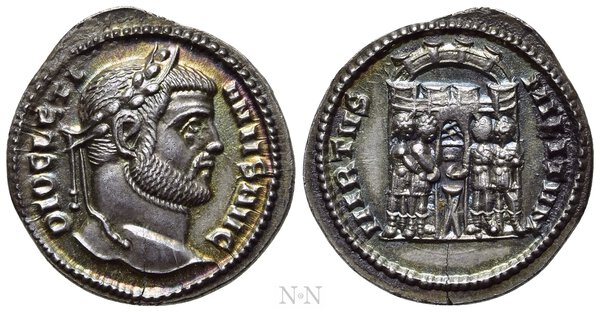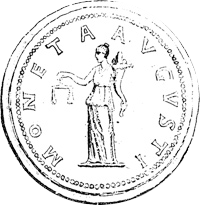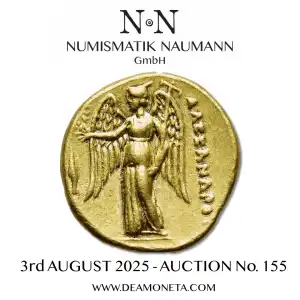Mint State - Rainbow Toning




DIOCLETIAN (284-305). Argenteus. Siscia.
Obv: DIOCLETIANVS AVG.
Laureate head right.
Rev: VIRTVS MILITVM.
The tetrarchs sacrificing over tripod before city enclosure with eight turrets.
RIC 43a.
The gradual breakdown of the unity of the empire was attempted to be remedied by emperors from Claudius II onward, but it was Diocletian who put in place an initial attempt at an overall reorganization of the empire and a thorough reform of the state, society and economy. The emperor associated in power the general Maximianus, to whom he entrusted the government of the western part of the empire, reserving the eastern part for himself. The two Augusti were later joined by two Caesars as collaborators in political and territorial management. The choice fell on Galerius for the East and Constantius Chlorus for the West. In this way, in 293, the initial diarchy system became a tetrarchy. Alongside his attempt at political reform, Diocletian flanked measures in the economic sphere to deal with the monetary disorder of the third century. In 301 he issued an edict by which he tried to impose a limit on food prices. In 294 he implemented a new monetary system. The aureus was stabilized at 1/60 of a pound and he created a new silver coin in very good alloy (above 95%), the argenteus, which permanently replaced the antoninianus. A system of copper alloy denominations based on a larger unit (c. 10g), conventionally called follis, and smaller fractions was also reintroduced. The system of imperial mints was also reorganized, with the opening of Londinium, Treveri, Aquileia, Ostia, Carthago, Thessalonica, Heraclea, Nicomedia, and Alexandria, which were added to the existing ones. Diocletian also initiated an extensive reform of the tax system, but this ended up depriving many citizens of their freedom of movement. Indeed, the new system bound workers in an inseparable relationship to the land and territory in which they resided. However, under Diocletian, the empire regained an albeit precarious stability under the banner of administrative decentralization.
Condition: Mint State.
Weight: 2.79 g.
Diameter: 19 mm.
Obv: DIOCLETIANVS AVG.
Laureate head right.
Rev: VIRTVS MILITVM.
The tetrarchs sacrificing over tripod before city enclosure with eight turrets.
RIC 43a.
The gradual breakdown of the unity of the empire was attempted to be remedied by emperors from Claudius II onward, but it was Diocletian who put in place an initial attempt at an overall reorganization of the empire and a thorough reform of the state, society and economy. The emperor associated in power the general Maximianus, to whom he entrusted the government of the western part of the empire, reserving the eastern part for himself. The two Augusti were later joined by two Caesars as collaborators in political and territorial management. The choice fell on Galerius for the East and Constantius Chlorus for the West. In this way, in 293, the initial diarchy system became a tetrarchy. Alongside his attempt at political reform, Diocletian flanked measures in the economic sphere to deal with the monetary disorder of the third century. In 301 he issued an edict by which he tried to impose a limit on food prices. In 294 he implemented a new monetary system. The aureus was stabilized at 1/60 of a pound and he created a new silver coin in very good alloy (above 95%), the argenteus, which permanently replaced the antoninianus. A system of copper alloy denominations based on a larger unit (c. 10g), conventionally called follis, and smaller fractions was also reintroduced. The system of imperial mints was also reorganized, with the opening of Londinium, Treveri, Aquileia, Ostia, Carthago, Thessalonica, Heraclea, Nicomedia, and Alexandria, which were added to the existing ones. Diocletian also initiated an extensive reform of the tax system, but this ended up depriving many citizens of their freedom of movement. Indeed, the new system bound workers in an inseparable relationship to the land and territory in which they resided. However, under Diocletian, the empire regained an albeit precarious stability under the banner of administrative decentralization.
Condition: Mint State.
Weight: 2.79 g.
Diameter: 19 mm.


